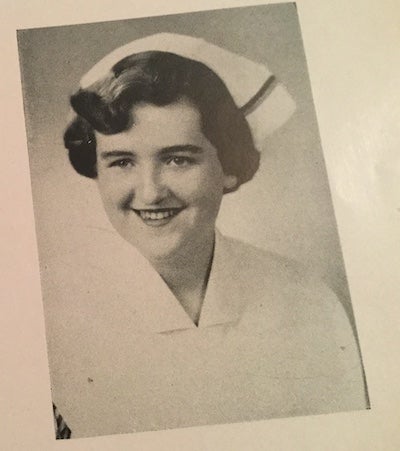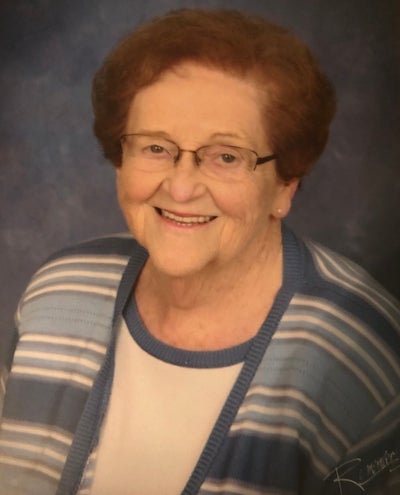Nearly 70 Years After GU Graduation, Nursing Alumna Looks Back on Career and Education
January 24, 2020 – When HelenMarie Dolton graduated from Georgetown’s nursing program in 1953, she left the campus with a bachelor’s degree, lifelong friendships, and, perhaps most surprisingly, an elevator operator’s license.

The last made her popular with her classmates, Dolton, who turns 89 in June, recalled during a recent phone conversation. She still has a copy of the license, which she received to operate the dormitory elevator.
“Our fifth year, we lived on the fifth floor, and that’s where the chapel was,” Dolton said, referring to the old Georgetown University Hospital complex on 35th Street NW, between N and Prospect Streets. “And they had these little tiny rooms that were originally for nuns. They just had a bed, a bureau, and a little desk. There was no room to turn around.” (St. Mary’s Hall on Reservoir Road would not open until three years after Dolton graduated.)
There was also a recreation lounge where nursing students socialized and smoked cigarettes, Dolton added with a laugh. “We were on the fifth floor, and it was a long trek up,” she said. “And most times, the housemother was not available to take us up. So I got, through the District of Columbia, an elevator operator’s license. And I still have a copy of that.”
Five-Year Program
Dolton grew up in Trenton, NJ, and learned about Georgetown from a high school friend, Elaine Schwab, who attended the university to study nursing and graduated in 1952. She has a copy of the letter that she and her mother sent to the nursing dean, Sister Agnes Miriam (1947-1952) of the Sisters of Charity of Nazareth (SCN), dated January 15, 1948, requesting an application.
Additionally, she has other correspondence, including letters of acceptance to both the College of Arts and Sciences, signed by the Rev. Lawrence McHugh, SJ, and the School of Nursing. The reason for both is that Dolton was a member of one of the last classes to participate in Georgetown’s five-year BSN program through which students took the first two years of classes in the College followed by the remaining three years in the School of Nursing.
“The first two years, we were really students in the College of Arts and Sciences,” she said, noting women were not yet admitted to the College. That did not occur until two decades later. “We participated in College activities, and we were more College of Arts and Sciences . . . than we were School of Nursing those first two years.”
Coursework that Dolton and her nursing classmates took, along with male students in the College, included biology, chemistry, English and one other language, logic, metaphysics, and religion. After those years, the students began three years of class- and clinical-based nursing education, including at Georgetown, Children’s Hospital, and the Seton Institute.
When she graduated in 1953, reflecting the structure of the five-year program, Dolton and her parents attended two Georgetown Commencement ceremonies: one for the university on June 8 and one for the School of Nursing on May 31.
Beginning the next year, according to Dr. Alma Woolley’s 2001 history of the school and an unpublished history by school administrator Rose McGarrity, the graduating class included students from the new four-year BSN program — which replaced both the five-year baccalaureate and the three-year diploma programs — and the RN-to-BSN program.
A Career in Education
Dolton said that when she began at Georgetown she had little idea she wanted to go into nursing education. As she was about to graduate with her BSN, Sister Agnes Miriam’s successor, Sister Angela Maria, SCN (1952-1958), encouraged her to stay and teach at Georgetown.

However, the new graduate wanted to return to New Jersey, where she went on to teach obstetrical nursing at St. Francis School of Nursing. After receiving a master’s degree in nursing at St. John’s University and serving as an administrator at St. Francis, Dolton founded the nursing program, in 1967, at Mercer County Community College. She stayed there until her retirement in 1992, when she was serving as dean of the Division of Science and Allied Health, which included nursing and several other fields.
“I learned as I went along,” she remarked about her 25-year career at the community college. “The president would take me out for lunch, and I’d get an additional department to supervise. My secretary used to laugh. ‘Oh,’ she said, ‘don’t go out to lunch with him.’”
Since her enrollment at Georgetown in 1948 and during her many years in nursing education, Dolton has seen changes in her profession. “What nurses do today is so much different than they did when I started,” she said, pointing to a deeper knowledge base in science and an increased level of decision-making authority. One thing, however, has not: “The patient is still the focus. Absolutely.”
A Busy Life
Dolton served, following an appointment by New Jersey Governor Richard J. Hughes (D), on the state’s board of nursing for four years. In her retirement, she has traveled, directed the CCD program at her church, taught computer skills to seniors, and served on the foundation board of Mercer County Community College. She is now a member of the board of trustees of St. Lawrence Rehabilitation Center/Morris Hall, which is sponsored by the Diocese of Trenton.
Various memories from Georgetown have stuck with her. She remembered Conrad, who drove a university bus that provided transportation for the nursing students to get to the hospital from their dormitory. The old school bus’s nickname, based on its paint color: “the blue bullet.”
She admitted falling out of a canoe into the Potomac River, and she still conjured a feeling of dread at having to prepare, on the night shift, tubes for the medical students to use the next day to take blood samples.
She chuckled about the negative review she received for her theatrical debut in a Mask and Bauble production.
Additionally, she participated (and has the first edition among her memorabilia) on the staff of the nursing school’s student newspaper Starch and Stripes, and she led the school’s sodality to honor the Blessed Mother.
“Georgetown has always been and is very close to me,” Dolton said. “I’m very proud of the fact that I graduated from Georgetown. And I thank Georgetown for everything they have given me.”
Editor’s correction: An earlier version of this story incorrectly stated that the Class of 1953 was the last five-year baccalaureate class. Information has also been added about the dates of the graduation ceremonies.
– Bill Cessato
- Tagged
- Nursing History
